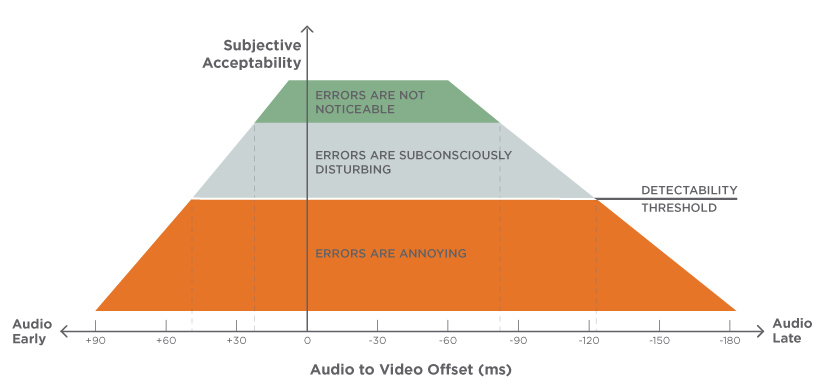Lip sync, also known as audio to video synchronization, refers to the matching of lip movements to live or recorded video, and it’s a critical element for good user experiences. Have you ever tried to watch a clip or a TV show where the lip sync wasn’t quite matching up? It’s frustrating and distracting; you probably had to shut it off and go eat cookies to make everything better.
Perception of Lip Sync Errors
Ideally, lip sync should be within +45 to -125 milliseconds* for most people not to notice. In general, if the audio is offset by more than 200 milliseconds, people definitely notice and start to twitch a little.
Our brains are at least two times more sensitive to early audio than to late audio. That’s because audio doesn’t come before video in the natural world. Do you see lightning first, or hear the crack of thunder? The slow speed of sound relative to the speed of light has conditioned us to expect to hear the audio after we’ve seen the corresponding event occur.

Subconscious Effects
The most unsettling lip sync errors may be the ones we can’t “see.” For most viewers, if the audio is between 45-25 milliseconds early and 90-125 milliseconds late, the brain does not consciously register a lip sync error. However, studies have indicated** that synchronization offsets in these bands can have the subconscious effect of making the program material seem less believable and therefore less trustworthy.
Lip Sync Battle!
Synchronizing audio and video that have been transmitted and processed separately (i.e. from multiple vendors) can range from difficult to apocalyptic. Luckily, Tesira manages the entire audio and video signal path for you. Tesira processing recognizes how long it takes for each signal to pass over the network, allowing it to accurately synchronize everything. The result is TesiraLUX’s robust, integrated lip sync management that strives to match audio and video synchronization within 20 milliseconds or less. Process, route, combine, or separate the audio and video signals at will — we’ve got you covered.
* ITU-R publication BT.1359 recommends the relative timing of audio and video for broadcasting.
** “Effects of Audio Video Asynchrony on Viewer’s Memory, Evaluation of Content and Detection Ability.” Stanford University.
